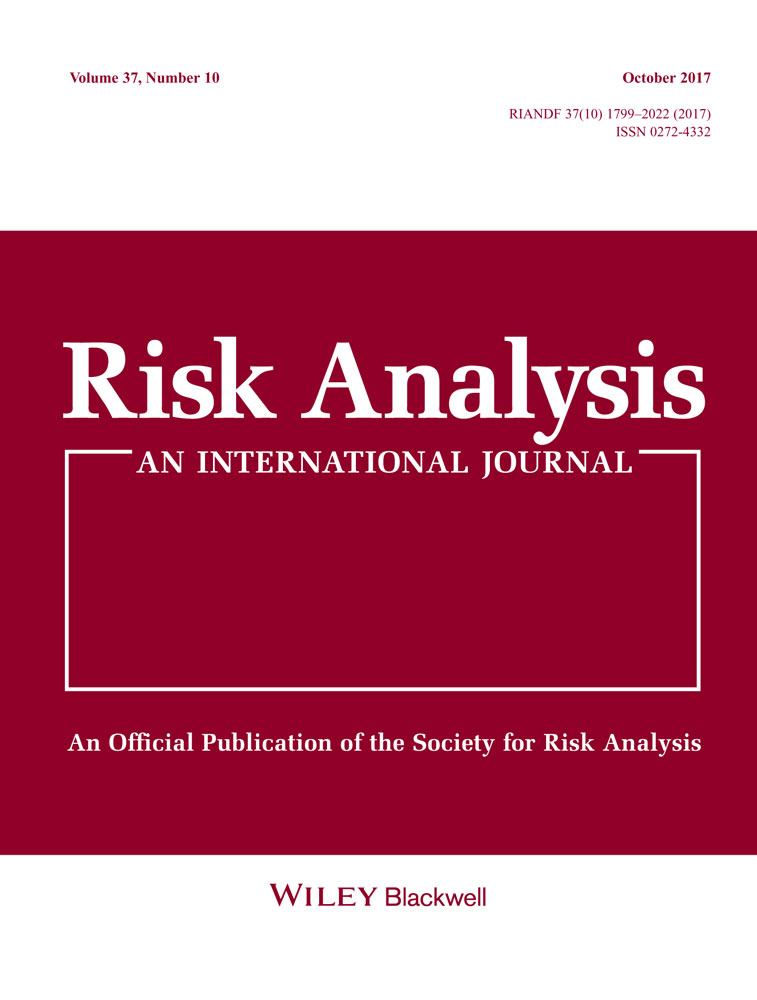A Blueprint for Full Collective Flood Risk Estimation: Demonstration for European River Flooding
Abstract
Floods are a natural hazard evolving in space and time according to meteorological and river basin dynamics, so that a single flood event can affect different regions over the event duration. This physical mechanism introduces spatio-temporal relationships between flood records and losses at different locations over a given time window that should be taken into account for an effective assessment of the collective flood risk. However, since extreme floods are rare events, the limited number of historical records usually prevents a reliable frequency analysis. To overcome this limit, we move from the analysis of extreme events to the modeling of continuous stream flow records preserving spatio-temporal correlation structures of the entire process, and making a more efficient use of the information provided by continuous flow records. The approach is based on the dynamic copula framework, which allows for splitting the modeling of spatio-temporal properties by coupling suitable time series models accounting for temporal dynamics, and multivariate distributions describing spatial dependence. The model is applied to 490 stream flow sequences recorded across 10 of the largest river basins in central and eastern Europe (Danube, Rhine, Elbe, Oder, Waser, Meuse, Rhone, Seine, Loire, and Garonne). Using available proxy data to quantify local flood exposure and vulnerability, we show that the temporal dependence exerts a key role in reproducing interannual persistence, and thus magnitude and frequency of annual proxy flood losses aggregated at a basin-wide scale, while copulas allow the preservation of the spatial dependence of losses at weekly and annual time scales.
1. INTRODUCTION
Global costs from weather-related hazards have increased in recent decades, and losses from storms and floods around the world account for most of the increase.1 These loss trends can largely be explained by regional socioeconomic factors such as increasing wealth, population growth, and increasing development in vulnerable areas.1-4 Focusing on flood hazard, the evolution of vulnerability and exposure along with hazard frequency and magnitude related to climate fluctuations require flood risk management strategies to evolve to meet the changing circumstances.5-8 Such policies also imply a shift toward more integrated flood risk management strategies comprising portfolios of structural flood protection assets such as dikes, levees, resilience-improved residences, and upstream retention areas,9 and nonstructural solutions such as property-level protection, land-use planning, and insurance arrangements.3, 8, 10 An effective implementation of evolving management strategies must account for key flood characteristics such as their inherent spread over many administrative/physical regions,11, 12 causing simultaneous collective losses, and their temporal clustering, resulting in flood-rich and flood-poor periods.13-16 In particular, modeling flood clustering is paramount to set up mitigation strategies that are not affected by the flood risk perception related to the alternation of flood-rich and flood-poor periods. Indeed, experience with floods is often considered to have a great impact on the recognition of risk, resulting, for instance, in a positive relationship between individual flood risk perceptions and demand for flood insurance.17, 18 Moreover, both the severity of the experienced negative consequences and the timing of the previous experience play an important role, as it can be expected that floods experienced in the distant past have only a limited influence on individual risk perceptions and mitigation behavior later.18 In this respect, the International Commission for the Protection of the Rhine (ICPR) estimated that flood awareness mostly diminishes within seven years after a flood and that only catastrophic disasters are remembered in the long term,19 and that flood damage is significantly lower in areas where people have recently experienced a flood event, which is attributed to a better preparedness of the population in the direct aftermath of a flood.20-22
Whether we focus on hazard (water discharge/level magnitude and frequency) or on impacts (losses magnitude and frequency), defining the frequency of regional flood events requires the use of multivariate frequency analysis of discharge values at multiple locations23 (e.g., stream gauge stations or grid points of the spatial domain affected by flood events). Different techniques have been proposed in the literature to perform multivariate frequency analysis. Focusing on flood hazard, Student t and skew-t copulas were used to model multisite flood events selected by preliminary univariate analyses of annual maximum discharge values and peaks over a fixed percentage threshold.24, 25 Critical multisite events to be included in the analysis are instead automatically selected by the Heffernan–Tawn conditional model26 devised for conditional peaks over threshold.27-29 Focusing on flood impacts, simplified versions of vine copulas were applied to model the hierarchical spatial dependence structure of flood losses.30, 31 In these cases, copulas were fitted to monthly peak discharge values yielded by a hydrological model, thus not requiring a preliminary flood event selection.32
Irrespective of the method of selecting regional flood events, the modeling strategies mentioned above deal with a limited number of extreme events, generally a few events per year, which are treated as temporally independent. The corresponding simulation procedures also generate temporally independent (but spatially dependent) realizations using, for instance, a Poisson distribution to model the number of events per year.28 However, stream flow dynamics are characterized by short- and long-term temporal dependence,33, 34 which influences not only the interannual fluctuations of the average process but also the magnitude and interarrival times of extreme events,35 resulting in extreme values more intense than expected under weak or no temporal dependence, and temporal clustering/overdispersion.16 Moreover, since rivers are characterized by different flow regimes based on the dominant climatological drivers in a given region, spatial patterns of potential flood events change along the calendar year according to the seasonal probability to observe simultaneous extreme events over different regions. For practical purposes, such as reinsurance pricing procedures, it is therefore important to know the calendar time of potential losses.
To accomplish this task, we move from event-based methods to a continuous approach that allows for modeling and simulation of spatially and temporally correlated hazard scenarios at a weekly time scale. The methodology falls in the framework of dynamic conditional copula,36-39 which consists of two modeling stages: first, at-site (univariate) stream flow properties, including marginal distributions, seasonality, and temporal dependence, are modeled by suitable time series models; since the model residuals (also known as innovations) are temporally independent and identically distributed but preserve spatial correlation, the spatial dependence structure is modeled by a suitable copula-based multivariate distribution in the second stage. As described in more detail in the next sections, combining at-site models and the joint distribution of their residuals provides a full spatio-temporal model suitable for continuous simulation. The copula model is called “dynamic conditional” because the joint distribution of residuals is conditioned on covariates (here, at-site stream flow dynamics), and can evolve in time accounting for seasonal fluctuations or other dynamics of the spatial correlation structure. The model is applied to 490 stream flow time series recorded across 10 of the largest basins across central and eastern Europe, and its performance is assessed by a set of collective risk indices summarizing “proxy” losses at different spatial and temporal aggregation scales. The article is organized as follows. Section 2. introduces the modeling framework and the data required for parameter estimation and validation. Section 3. discusses empirical results referring to European stream flow data. Finally, conclusions are drawn in Section 4..
2. DATA AND METHODOLOGY
2.1. Preliminary Remarks on Modeling Strategy
Unlike univariate frequency analysis, where critical events are uniquely defined when the variable of interest exceeds a given critical value, in conventional multivariate flood frequency analysis such a definition is not unique because multiple variables can be combined in different ways according to the nature of the physical process under study and/or the aim of the analysis.25, 40, 41 Dealing with floods over large areas, events usually propagate along the river network spanning up to several days based on geophysical aspects such as time of concentration, antecedent soil moisture conditions, and nature of the meteorological forcings. Event definition and corresponding time scales also depend on specific applications. For example, (re)insurance policies introduce a time window, the so-called hours clause, that identifies a single event so that the damages occurring in such time interval are ascribed to the same event, thus resulting in a single aggregate loss.25 Typically, the hours clause is 72 or 168 hours (one week).
In a classical frequency analysis approach, independent multisite flood events can be identified by sliding widows of size equal to the hours clause, thus selecting the maximum value for each site within the time window. The window is then shifted by the expected flood travel time in the drainage network to guarantee the independence of the events. Finally, the most intense events are selected using severity indices that summarize the overall intensity by the weighted sums of the at-site return periods (annual exceedance probabilities) of the event's flow values at each location.25
Moving from frequency analysis of independent events to continuous modeling, we need a different selection method. It consists of selecting the maximum value of discharge within each calendar week. Even though physical events are not bounded by calendar weeks, this method is reasonable since (i) it yields a large set of possible scenarios within the hours clause; (ii) the use of calendar weeks allows for a detailed analysis of the spatial and temporal evolution of the flood risk through the year, thus providing refined information on how the potential losses aggregate in space and time; and (iii) weekly maxima are a reasonable compromise between threshold-based selection and the direct use of all daily data; indeed, they allow us to reduce redundant information (and reduce the computational effort) but retain more data than usually used in classical frequency analysis (thus improving the reliability of results).
 (1)
(1)2.2. Data Set
The data set comprises 490 daily stream flow time series across 10 of the major basins in Europe (data were obtained from the Global Runoff Data Centre, Federal Institute of Hydrology, Koblenz, Germany). The time series were selected in order to have the maximum number of sequences with maximum temporal overlap (namely, 36 years from 1969 to 2005) and less than 10% of missing values; Fig. 1(a) shows the study area and stream gauge locations.
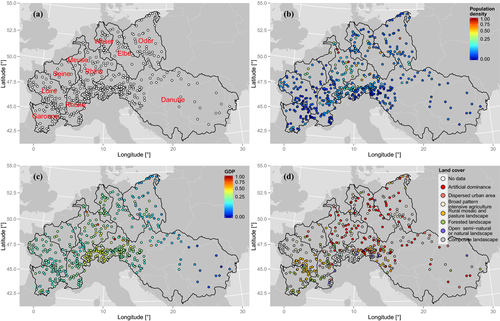
Population density1 and GDP per capita2 at the NUTS 3 level3 referring to 2011 are obtained from the EUROSTAT website,4 while land cover (dominant land cover types) has been retrieved from CORINE 2000.5 Since E and V act as weights for H, all variables are standardized in the range [0, 1], introducing a saturation at 5% for population density and GDP per capita to avoid boundary effects of extreme low and high values (Figs. 1(b) and 1(c)).43 CORINE land cover data consist of eight classes of dominant land cover types, which are also standardized in the unit interval [0, 1] (Fig. 1(d)).
2.3. Spatio-Temporal Model
The methodology proposed in this study aims to model and simulate weekly discharge maxima preserving the spatial and temporal dependence structures. It builds on modeling frameworks previously developed in the context of continuous simulation of rainfall fields45-47 and radar rainfall error fields.48 The proposed method is based on Sklar's theorem49 extended to conditional distributions,37 which allows the decomposition of a conditional joint distribution into marginal distributions and a copula, thus splitting the modeling of the marginal temporal dependence structure and joint spatial dependence under the hypothesis of separability of spatio-temporal correlation function. This approach is well known in econometrics38, 39 but is less common in hydrometeorology.50, 51
 , where
, where  is a vector of d generic random variables with marginal distributions
is a vector of d generic random variables with marginal distributions  , for
, for  , and C is their copula. Since the copula theory was originally developed for (time) independent and identically distributed (iid) multivariate random variables, it may not be appropriate to describe many real-world problems, such as persistent hydroclimatic time series at multiple locations or multiple sequences of stock price values, for which this hypothesis is not realistic. However, the concept of conditional copulas37 allows us to overcome this limit. In more detail, time dependence can be modeled by conditioning
, and C is their copula. Since the copula theory was originally developed for (time) independent and identically distributed (iid) multivariate random variables, it may not be appropriate to describe many real-world problems, such as persistent hydroclimatic time series at multiple locations or multiple sequences of stock price values, for which this hypothesis is not realistic. However, the concept of conditional copulas37 allows us to overcome this limit. In more detail, time dependence can be modeled by conditioning  on the previous observations
on the previous observations  and other generic exogenous variables W. In the time series context, Sklar's theorem may be extended as follows:37, 38, 56
and other generic exogenous variables W. In the time series context, Sklar's theorem may be extended as follows:37, 38, 56
 (2)
(2) is the copula at times t, and
is the copula at times t, and
 (3)
(3) ,
,  , and possible covariates
, and possible covariates  . In order for
. In order for  to be a valid conditional joint distribution function, Sklar's theorem for conditional distributions requires that the conditioning set
to be a valid conditional joint distribution function, Sklar's theorem for conditional distributions requires that the conditioning set  must be the same for both marginal distributions and the copula. However, when each variable depends on its own previous lags but not on the lags of any other variables, Equation 2 describes a valid conditional distribution.57 Since in the present context, the random variables X are the weekly maxima of daily average stream flow recorded at d different sites and
must be the same for both marginal distributions and the copula. However, when each variable depends on its own previous lags but not on the lags of any other variables, Equation 2 describes a valid conditional distribution.57 Since in the present context, the random variables X are the weekly maxima of daily average stream flow recorded at d different sites and  denotes the at-site information related to the past flow values, the previous hypothesis corresponds to assuming that the cross-correlation (spatial correlation) can be studied independently of the autocorrelation (temporal correlation), namely, that the spatio-temporal correlation function is separable (in space and time components). The conditional copula method is also referred to as the dynamic copula method when it involves the modeling of the time-varying marginals and dependence structures.
denotes the at-site information related to the past flow values, the previous hypothesis corresponds to assuming that the cross-correlation (spatial correlation) can be studied independently of the autocorrelation (temporal correlation), namely, that the spatio-temporal correlation function is separable (in space and time components). The conditional copula method is also referred to as the dynamic copula method when it involves the modeling of the time-varying marginals and dependence structures.The separability hypothesis allows for splitting the analysis and modeling of marginals and dependence structure as follows.58-60
First, the d time series of weekly maximum values are preliminarily standardized by normal quantile transformation (NQT) and deseasonalized. Then the deseasonalized series are modeled by suitable time series models. Based on previous analyses on the same data set,16 we used three different options: (i) autoregressive fractionally integrated moving average (ARFIMA) models that allow the reproduction of both short- and long range- (time) dependence, (ii) autoregressive moving average (ARMA) models including only short-range dependence, and (iii) a benchmark iid Gaussian noise. These three models for temporal dependence allow for the assessment of the impact of temporal correlation on the basin-wide aggregated proxy losses.
Second, exploiting the separability hypothesis, the residuals of the univariate time series models at different locations and time steps t are temporally independent copies of d spatially dependent random variables that can be modeled by a multivariate distribution. Among the available options, only few classes of copulas/multivariate distributions allow effective high-dimensional extensions preserving the variability of the degree of association between different locations. These classes include the so-called vine copulas,61, 62 meta-elliptical copulas,63 and extensions of Gaussian and Student multivariate distributions such as skew-normal and skew-t,64, 65 and v-copulas.66
Vine copulas allow for building dependence structures suitable for describing conditional relationships of random variables naturally organized according to a hierarchical (tree-like) structure, such as flow records across a river network. Based on these properties, vine copulas have been applied in collective flood risk/loss assessment;30, 31 however, since this class requires the definition of  bivariate copulas, and the d variables can be combined to form up to
bivariate copulas, and the d variables can be combined to form up to  different d-dimensional vine copulas,67 only simplified versions (accounting for a reduced number
different d-dimensional vine copulas,67 only simplified versions (accounting for a reduced number  of possible mutual conditional relationships) were applied in large-scale analyses. On the other hand, meta-elliptical copulas and, more generally, multivariate distributions involving a correlation matrix (such as Gaussian and Student, and v-copulas) describe all
of possible mutual conditional relationships) were applied in large-scale analyses. On the other hand, meta-elliptical copulas and, more generally, multivariate distributions involving a correlation matrix (such as Gaussian and Student, and v-copulas) describe all  mutual pairwise relationships, but do not account for explicit modeling of possible hierarchical structures. Nonetheless, such a class of copulas was also used in flood risk assessment along a river network.25
mutual pairwise relationships, but do not account for explicit modeling of possible hierarchical structures. Nonetheless, such a class of copulas was also used in flood risk assessment along a river network.25
 (4)
(4) is a d-dimensional Gaussian distribution with correlation matrix Σ,
is a d-dimensional Gaussian distribution with correlation matrix Σ,  , and
, and  is the univariate distribution of
is the univariate distribution of  , for
, for  ; and (iii) a grouped t-copula,68 which is a generalization of the classical Student t-copula:
; and (iii) a grouped t-copula,68 which is a generalization of the classical Student t-copula:
 (5)
(5) denotes a centered multivariate Student distribution with correlation matrix Σ and univariate Student marginals
denotes a centered multivariate Student distribution with correlation matrix Σ and univariate Student marginals  with ν degrees of freedom. A grouped t-copula arises as follows:68 let
with ν degrees of freedom. A grouped t-copula arises as follows:68 let  be independent of a standard uniform random variable U, and
be independent of a standard uniform random variable U, and  the distribution function of
the distribution function of  , where
, where  . If we partition
. If we partition  into m subsets of sizes
into m subsets of sizes  , and define
, and define  , for
, for  , therefore the vector
, therefore the vector
 (6)
(6) follow an s1-dimensional t-distribution with ν1 degrees of freedom, and each of the m subsets
follow an s1-dimensional t-distribution with ν1 degrees of freedom, and each of the m subsets  is distributed as
is distributed as  -dimensional t-distribution with
-dimensional t-distribution with  degrees of freedom. Therefore the vector
degrees of freedom. Therefore the vector
 (7)
(7) parameters controlling the tail dependence and so the simultaneous occurrence of extreme events. The grouping procedure allows us to cluster together sets of time series according to some common behavior or property (e.g., membership in a given basin, basin similarities, or other factors). In the present study, time series are grouped according to the overall strength of association among the residuals of the AR(FI)MA models fitted on the deseasonalized series, under the assumption that the tails tend to cluster similarly to the body of the distribution. Of course, other options are possible, but this aspect is secondary in the present discussion. The combination of three marginal (temporal) dependence structures (independence (IND), ARMA, and ARFIMA) and three spatial dependence structures (independence (IND), Gaussian (GAU), and grouped t-copula (GT)) results in nine model configurations (denoted as IND-IND, IND-GAU, IND-GT, etc.) that are used to assess the impact of time persistence, spatial correlation, and their combination on the aggregated proxy losses (weighted areal hazard).
parameters controlling the tail dependence and so the simultaneous occurrence of extreme events. The grouping procedure allows us to cluster together sets of time series according to some common behavior or property (e.g., membership in a given basin, basin similarities, or other factors). In the present study, time series are grouped according to the overall strength of association among the residuals of the AR(FI)MA models fitted on the deseasonalized series, under the assumption that the tails tend to cluster similarly to the body of the distribution. Of course, other options are possible, but this aspect is secondary in the present discussion. The combination of three marginal (temporal) dependence structures (independence (IND), ARMA, and ARFIMA) and three spatial dependence structures (independence (IND), Gaussian (GAU), and grouped t-copula (GT)) results in nine model configurations (denoted as IND-IND, IND-GAU, IND-GT, etc.) that are used to assess the impact of time persistence, spatial correlation, and their combination on the aggregated proxy losses (weighted areal hazard).- (1) Each time series of stream flow weekly maxima is preprocessed by applying the NQT
 , where
, where  denotes the inverse of the standard Gaussian cumulative distribution function and
denotes the inverse of the standard Gaussian cumulative distribution function and  is the Weibull version of the empirical cumulative distribution function. These standardized series are therefore deseasonalized by subtracting the empirical average value for each calendar week
is the Weibull version of the empirical cumulative distribution function. These standardized series are therefore deseasonalized by subtracting the empirical average value for each calendar week  ,
,  , from each observation
, from each observation  , and then dividing by the calendar-day standard deviation
, and then dividing by the calendar-day standard deviation  ,
,  69
69 - (2) These deseasonalized time series are then modeled by AR(FI)MA models, which are used to model the at-site information
 , where
, where  , and
, and  and
and  denote the deseasonalized flow values and the AR(FI)MA residuals at times
denote the deseasonalized flow values and the AR(FI)MA residuals at times  , respectively. The term
, respectively. The term  corresponds with w in Equation 3. The optimal orders of the autoregressive and moving average components were selected by an automatic selection procedure based on the Akaike information criterion,70 which is known to be asymptotically equivalent to a leave-one-out cross-validation procedure.
corresponds with w in Equation 3. The optimal orders of the autoregressive and moving average components were selected by an automatic selection procedure based on the Akaike information criterion,70 which is known to be asymptotically equivalent to a leave-one-out cross-validation procedure. - (3) The dependence structure of the temporally uncorrelated (but spatially correlated) residuals are therefore modeled by Gaussian copulas and grouped t-copulas. For both copulas the required correlation matrix is estimated on a weekly basis (to account for seasonal fluctuations of the spatial correlation) by using the Spearman rank correlation coefficient
 and then the relationship between
and then the relationship between  and the Pearson correlation coefficient
and the Pearson correlation coefficient  . This allows for a nonparametric estimation that is not affected by the possible failure of the hypothesis of Gaussian marginals and is effective if the spatial and/or temporal dependence structures are meta-elliptical. The correlation matrices are finally corrected to guarantee the positive definiteness.71 For the grouped t-copulas, eight groups were identified by a hierarchical clustering procedure based on the dissimilarity matrix of the AR(FI)MA residuals and Ward's minimum variance method. For each group the number of degrees of freedom is computed by the maximum likelihood method.
. This allows for a nonparametric estimation that is not affected by the possible failure of the hypothesis of Gaussian marginals and is effective if the spatial and/or temporal dependence structures are meta-elliptical. The correlation matrices are finally corrected to guarantee the positive definiteness.71 For the grouped t-copulas, eight groups were identified by a hierarchical clustering procedure based on the dissimilarity matrix of the AR(FI)MA residuals and Ward's minimum variance method. For each group the number of degrees of freedom is computed by the maximum likelihood method. - (4) To simulate space–time dependent flood hazard scenarios (over the stream gauge locations), the estimated (weekly) correlation matrices are used to simulate suitable d-dimensional vectors following a multivariate Gaussian distribution and grouped t-copula with Gaussian marginals (see Daul et al.68 for details on grouped t-copula simulation). These spatially correlated vectors are temporally independent.
- (5) The temporally independent sequences resulting from step (4) for each spatial location are used as spatially correlated innovations to feed at-site AR(FI)MA models. This allows for the simulation of random sequences
 that are both spatially and temporally correlated.
that are both spatially and temporally correlated. - (6) Finally, the seasonal component is reintroduced by applying the transformation
 ,
,  , and the resulting series are transformed into a sequence of annual nonexceedance probabilities by
where
, and the resulting series are transformed into a sequence of annual nonexceedance probabilities by
where (8)
(8) denotes the weekly nonexceedance probability. This procedure removes simulated values corresponding to virtual flow values exceeded more than once a year, for which the annual exceedance probability
denotes the weekly nonexceedance probability. This procedure removes simulated values corresponding to virtual flow values exceeded more than once a year, for which the annual exceedance probability  is equal to unity. Hence, the resulting scenarios preserve only values of potential interest for design and management, discarding all the low virtual hazard values.
is equal to unity. Hence, the resulting scenarios preserve only values of potential interest for design and management, discarding all the low virtual hazard values.
3. MODELING RESULTS
To assess the performance of the modeling framework in terms of aggregated proxy losses, the hazard sequences  are multiplied by the standardized values of exposure and vulnerability according to Equation 1, as discussed in Section 2.1.. These proxy losses are then aggregated at the basin scale and analyzed on a monthly and annual basis. Model performance is evaluated by a set of indices: (i) magnitude of weekly and annual losses, (ii) weekly probability of observing a loss, (iii) number of simultaneous weekly and annual losses (i.e., number of basins experiencing losses simultaneously), (iv) pairwise spatial correlation of weekly and annual loss time series for each pair of basins in the study area, and (v) the probability of observing simultaneous weekly losses for each pair of basins in the study area. The first two indices quantify the performance of the at-site (marginal) components of the model, while the other three measures allow for checking the effect of the spatial components in terms of magnitude and frequency of basin-wide proxy losses.
are multiplied by the standardized values of exposure and vulnerability according to Equation 1, as discussed in Section 2.1.. These proxy losses are then aggregated at the basin scale and analyzed on a monthly and annual basis. Model performance is evaluated by a set of indices: (i) magnitude of weekly and annual losses, (ii) weekly probability of observing a loss, (iii) number of simultaneous weekly and annual losses (i.e., number of basins experiencing losses simultaneously), (iv) pairwise spatial correlation of weekly and annual loss time series for each pair of basins in the study area, and (v) the probability of observing simultaneous weekly losses for each pair of basins in the study area. The first two indices quantify the performance of the at-site (marginal) components of the model, while the other three measures allow for checking the effect of the spatial components in terms of magnitude and frequency of basin-wide proxy losses.
Before analyzing the model results in terms of performance indices, Fig. 2 shows some examples of events simulated by the model incorporating spatial dependence via grouped t-copula and temporal dependence via ARFIMA models (GT-ARFIMA). Each panel shows the flooding “active” locations where the at-site discharge return period is equal to or larger than five years. These events show well-defined spatial patterns involving, for instance, the lower Rhine, Elbe, and Weser (event 1), or the Alpine region (event 2), or the Rhine, Weser, and upper Danube (event 3), or the Elbe and Oder (event 15). Despite the purely statistical nature of the hazard model, it is able to reproduce physical properties such as the simultaneous (within one-week window) flooding condition along the main stream of the Rhine (events 1, 3, 4, 7, 8, 11, 13), Weser (events 1, 3, 7, 10, 13), and Elbe (events 7, 8, 10, 13, 15). Physical coherence is less evident for the other rivers because of the limited number of stations available along the main stream as well as the relative disconnection between subcatchments feeding the main river,31 as is the case of the Danube, for instance.
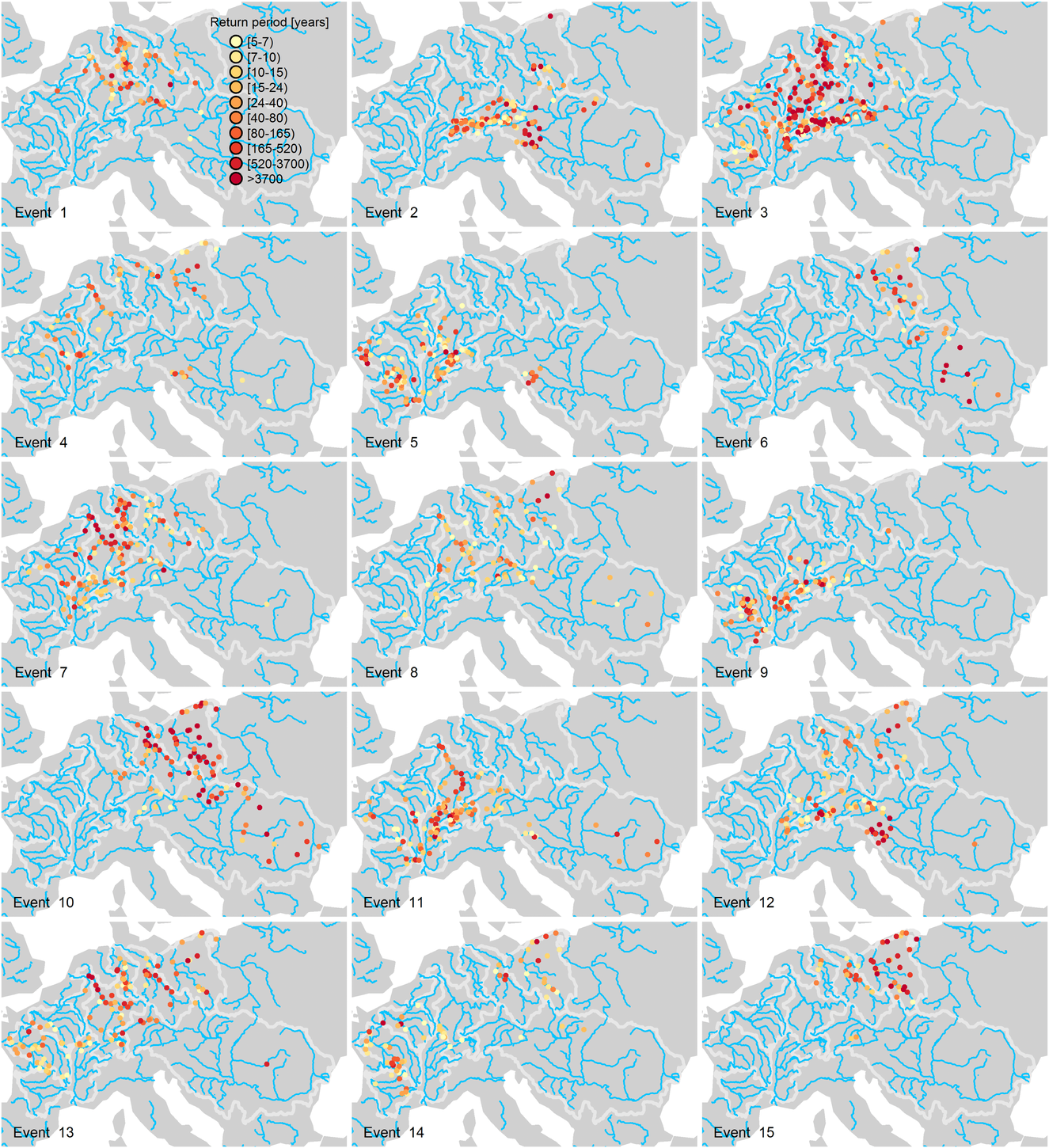
Fig. 3 compares the observed weekly proxy losses aggregated over the 36 years with maximum data overlap (see Section 2.2.) and the values obtained by 277 samples of 36 years extracted from 10,000 simulated years for the simplest and most complex models in terms of spatio-temporal structure: the first model is the simplest benchmark involving spatial and temporal independence (IND-IND), while the second is GT-ARFIMA. Since the focus is on weekly values, stream flow seasonality dominates the patterns of the proxy losses, but introducing spatial and temporal dependence structures results in increased variability (more evident in the low flow periods) and persistence (evident in the smoothed seasonality characterizing the high-flow periods).

This behavior generally holds true for the other model combinations as well; however, the separate effect of spatial and temporal dependence is more evident in the basin-wide proxy losses aggregated at the annual time scale. Fig. 4 summarizes modeling results in terms of q–q plots for all the basins and model combinations. The models involving temporal independence (IND-IND, GAU-IND, GT-IND) tend to underestimate both the median values (i.e., tend to be biased) and the interannual variability of the magnitude of the proxy losses. On the other hand, there is little difference between ARMA and ARFIMA results. This depends on the automatic selection procedure, which can yield ARMA configurations able to mimic long-range dependence properties of ARFIMA models. Indeed, the main difference between these two alternatives is the smaller number of parameters of the fitted ARFIMA models compared to ARMA. In other words, the fractional differencing term is able to account for most of the temporal dependence, thus resulting in more parsimonious optimal models when compared with ARMA, which in turn require a larger number of parameters to describe the observed time series. Since the presence of long-range dependence in stream flow time series was widely recognized in the literature,72-76 ARFIMA models seem to offer a coherent option, bearing in mind their limits.77
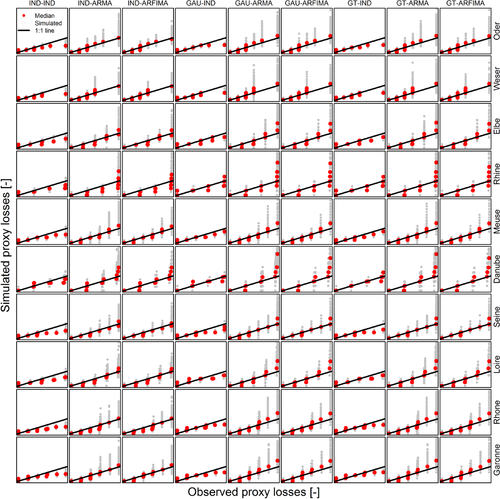
Fig. 5 shows the probabilities of observing a loss in each basin and calendar week for observed series, and IND-IND and GT-ARFIMA simulated sequences. As for the losses' magnitude, seasonality is the most evident feature, along with the higher variability and persistence characterizing the models involving temporal dependence structure.

Fig. 6 shows the pairwise values of the Kendall correlation coefficient  between the weekly proxy losses at the basin scale. It should be noted that the good reproduction of the correlation of basin-wide losses is an indirect result of the spatial component of the model reproducing the spatial correlation among at-site hazard time series. Therefore, even though some discrepancies are expected, the overall performance is rather satisfactory, with little difference between GAU and GT dependence structures. Performance deteriorates when losses are aggregated at the annual scale (Fig. 7). However, in 28 cases of 45, spatial dependence structures yield values closer to the observed than the IND setting. In a few cases, GAU and GT structures reproduce approximately the observed spatial independence, while in the remaining cases there is a tendency to overestimate the spatial correlation.
between the weekly proxy losses at the basin scale. It should be noted that the good reproduction of the correlation of basin-wide losses is an indirect result of the spatial component of the model reproducing the spatial correlation among at-site hazard time series. Therefore, even though some discrepancies are expected, the overall performance is rather satisfactory, with little difference between GAU and GT dependence structures. Performance deteriorates when losses are aggregated at the annual scale (Fig. 7). However, in 28 cases of 45, spatial dependence structures yield values closer to the observed than the IND setting. In a few cases, GAU and GT structures reproduce approximately the observed spatial independence, while in the remaining cases there is a tendency to overestimate the spatial correlation.
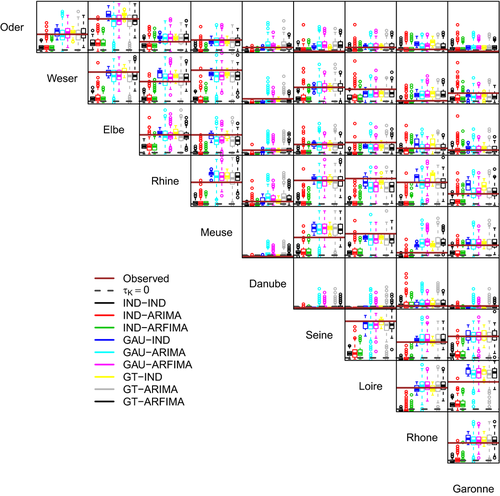
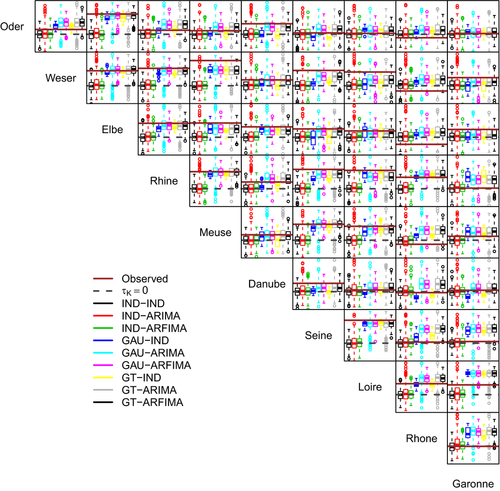
An alternative assessment of the spatial dependence is given by the number of basins simultaneously affected by a basin-wide loss the same week or year. Results for the nine model configurations are summarized in terms of q–q plots in Figs. 8 and 9 for weekly and annual scale, respectively. For weekly scale, models involving spatial independence (IND-IND, IND-ARMA, and IND-ARFIMA) underestimate the number of simultaneous basins affected by proxy losses with exceedance probability lower than once per year (in average), while GAU and GT models correctly reproduce the observed behavior. Aggregation at the annual scale shows the effect of temporal and spatial structures. Models involving spatial independence show limited ability to describe the simultaneous occurrence of spatial losses, while GAU and GT models provide better results even though a residual bias is still present. This bias is positive when temporal dependence is not accounted for, while it is negative for models with AR(FI)MA components. However, ARFIMA structures yield values closer to the expected than ARMA, in terms of variability.
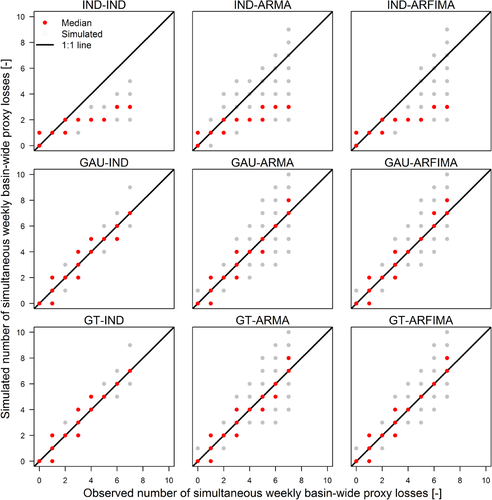
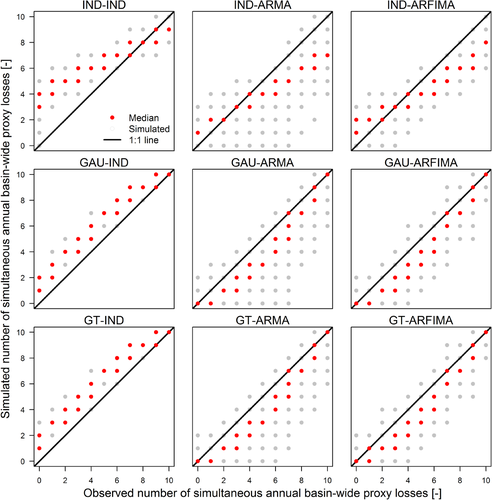
We finally checked the framework capability of modeling the weekly probability  of observing simultaneous basin-wide aggregated losses (with exceedance probability lower than once per year on average) in each pair of basins in the considered area. This information can be used for management strategies in order to optimize, for instance, (re)insurance policies accounting for simultaneous risk in different areas such as river basins or countries. Fig. 10 further confirms the advantages of introducing spatial dependence in a hazard model. Especially notable is the low probability of observing simultaneous losses in the Danube basin and the other European basins. This is mainly related to the different seasonal pattern characterizing the Danube basin, whose dynamics are driven by heterogeneous meteorological forcings acting both across the entire basin, which is much larger than the others, and in single subcatchments.78-80
of observing simultaneous basin-wide aggregated losses (with exceedance probability lower than once per year on average) in each pair of basins in the considered area. This information can be used for management strategies in order to optimize, for instance, (re)insurance policies accounting for simultaneous risk in different areas such as river basins or countries. Fig. 10 further confirms the advantages of introducing spatial dependence in a hazard model. Especially notable is the low probability of observing simultaneous losses in the Danube basin and the other European basins. This is mainly related to the different seasonal pattern characterizing the Danube basin, whose dynamics are driven by heterogeneous meteorological forcings acting both across the entire basin, which is much larger than the others, and in single subcatchments.78-80
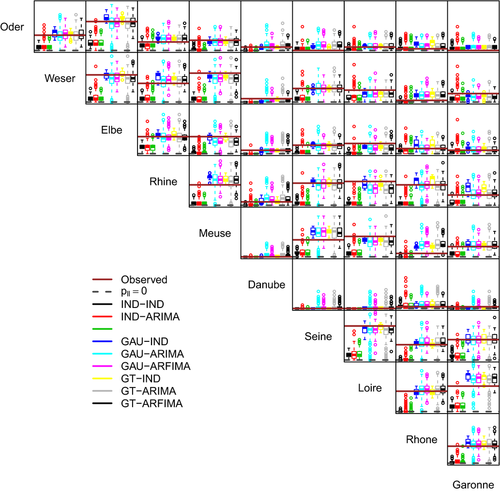
4. CONCLUSIONS
Flood hazard is a fundamental component of design and management procedures for flood risk assessment. Flood hazard is usually quantified by flood frequency analyses based on extreme values such as annual maximum values or values over a high threshold. However, these approaches often rely on a limited number of data. In order to exploit the information contained in all the available data, we proposed a continuous simulation approach incorporating both spatial and temporal dependence. The proposed methodology is general and balances between a more efficient use of available data, operational aims (e.g., hours clause policy), and a relatively simple model architecture. In particular, we merge spatial and temporal dependence structures under the hypothesis of separability, which makes the conditional copula widely applicable to real-world problems.
Using a large data set of daily stream flow time series recorded in the main river basins across central and eastern Europe, we assessed the performance of the model in terms of proxy losses aggregated at the basin spatial scale, and weekly and annual time scales. Proxy losses are defined as the product of hazard scenarios (observed or simulated), and vulnerability and exposure, which in turn are approximated by simple socioeconomic proxy indices easily retrievable from public databases. Such proxy losses can also be seen as weighted hazard values useful to quantify the areal (e.g., basin-wide or state-wide) hazard accounting for the effect of the local hazard magnitude in a simplified but effective fashion.
The proposed framework allows for the coupling of a variety of spatial and temporal dependence structures. In this respect, the choice of the optimal model structure (spatial and temporal modules) should be based on the reproduction of a suitable set of statistics of interest (such as spatially and temporally aggregated measures) rather than some standard indices involving the same quantities used in the fitting stage. The use of simple model benchmarks for the sake of comparison is also recommended along with model structures of intermediate complexity in order to evaluate the impact of the single components. From this point of view, the modular structure resulting from conditional copulas and the corresponding simple sampling algorithms allow for the relatively fast simulation of large samples from different model structures to be used for a post hoc validation.
From an operational point of view, based on the empirical results reported in this study as well as previous preliminary analyses on the same data set16 and conceptual remarks concerning the parsimony principle,77 models involving long-range dependence, such as ARFIMA or generalized Hurst-Kolmogorov,81 are suggested to describe the at-site (marginal) stream flow dynamics. In fact, one or two parameters controlling short-range dependence and one parameter describing long-range dependence are often sufficient to summarize the key linear properties of stream flow signals. In this respect, fitting models not including a long-range dependence component (e.g., ARMA) usually results in a larger number of parameters attempting to mimic long-range dependence. As far as the spatial dependence structure is concerned, spatial independence is surely an oversimplified assumption overlooking river network connections and interbasin dependence, while a simple Gaussian copula is a more realistic option embedding observed pairwise correlation between stream gauges. On the other hand, the additional parameters (degrees of freedom) of grouped t-copulas allow the control of upper tail dependence, that is, the joint occurrence of extreme values as well as the tuning of this property for subsets of stream flow series clustering together according to some physical criterion such as membership in a given drainage basin or subcatchment or in the main stream of a river network. Moreover, grouped t-copulas yield standard t-copulas when the number of groups is equal to one, and they tend to converge to Gaussian copulas for large values of degrees of freedom. Therefore, t-copulas introduce useful flexibility with a moderate number of additional parameters and include other simpler models as special cases, making them a suitable compromise between too simple competitors and more complex (highly parameterized) models.
Empirical results show the importance of accounting for spatial and temporal dependence in hazard modeling to reproduce the simultaneous occurrence of extreme events, interannual variability, and persistence. Continuous simulation also allows for a more accurate simulation of spatial hazard events by identifying and reproducing coherent spatial patterns along the calendar year. This information can be used to refine flood management strategies identifying the areas simultaneously prone to flood hazard, and quantifying the corresponding probability to have joint regional losses. Finally, it should be noted that the modeling framework can easily be adapted and improved by introducing different spatial components (i.e., hierarchical dependence structures), and temporal modules (e.g., nonlinear temporal models) in order to refine the analysis or adapt it to other geophysical variables and hazards.
ACKNOWLEDGMENTS
This work was supported by the Engineering and Physical Sciences Research Council (EPSRC) Grant EP/K013513/1 “Flood MEMORY: Multi–Event Modelling Of Risk & recoverY,” and Willis Research Network. We acknowledge the Global stream flow Data Centre (GRDC; Federal Institute of Hydrology [BfG], Koblenz, Germany) for providing the daily river flow data. We wish to thank the managing editor, Prof. Karen Lowrie (Rutgers University, NJ, USA), the area editor, Prof. Seth Guikema (University of Michigan, MI, USA), and an anonymous reviewer for their constructive remarks and criticisms that helped improve the original article. The analyses were performed in R 82 by using the contributed packages forecast,83 fracdiff,84 Matrix,85 and mvtnorm.86
 .
.


